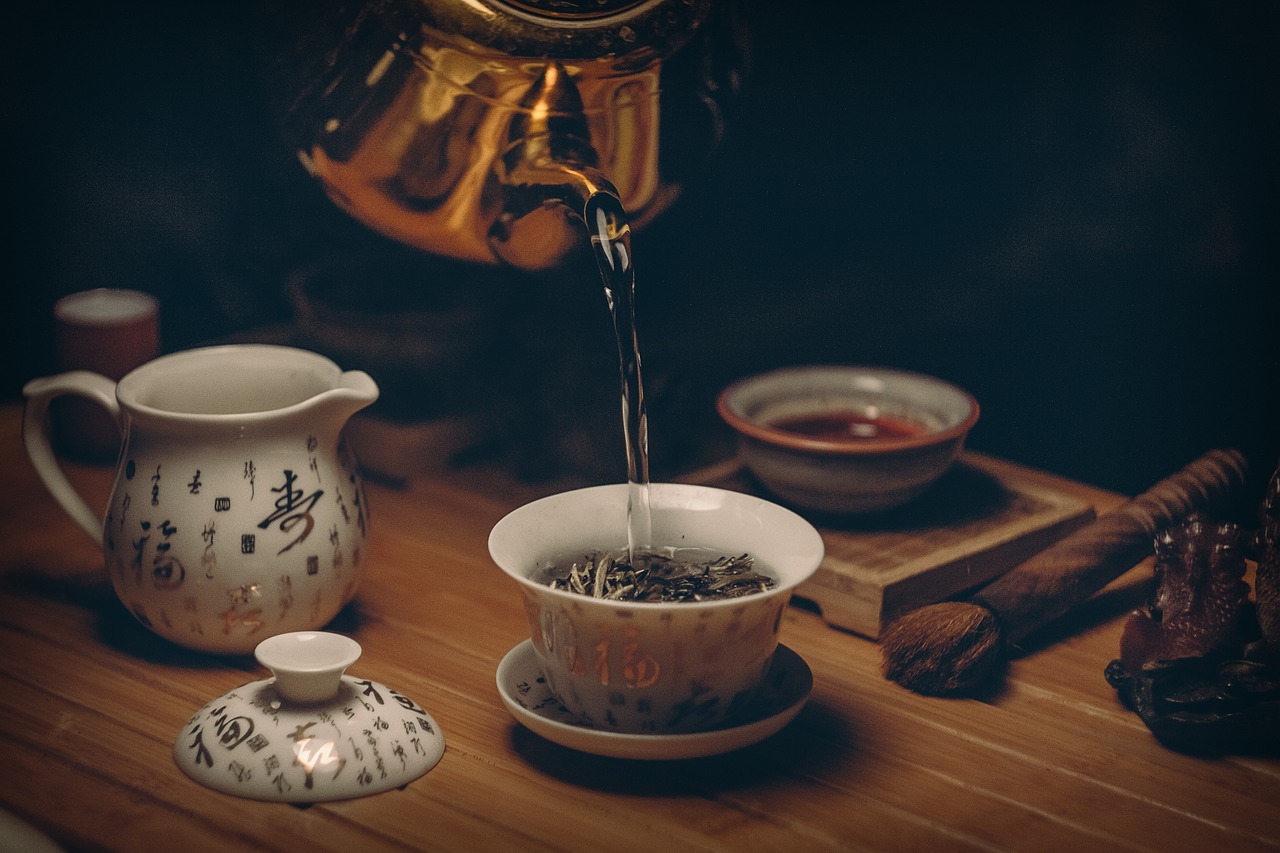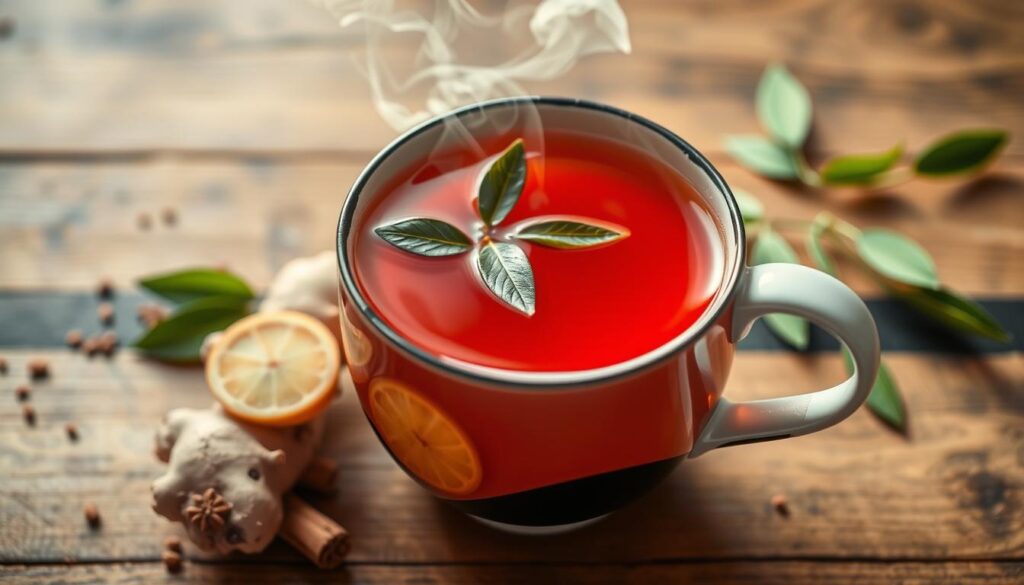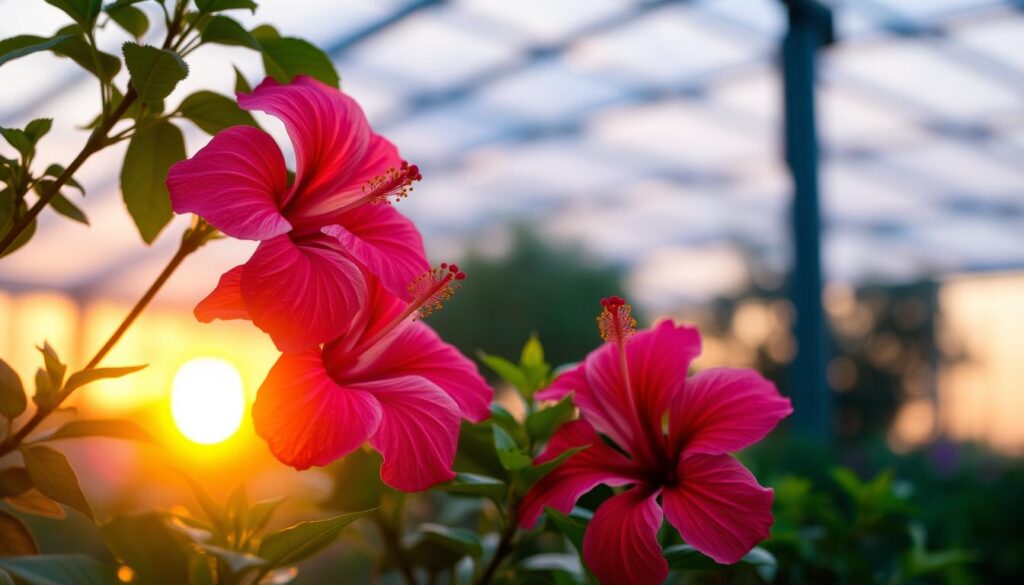Do you want to discover the solution for high blood pressure?
Anúncios
Discover a natural tea recipe for high blood pressure that’s both soothing and beneficial for your heart health. Start sipping your way to wellness!
This short guide is for adults in the United States who want a practical, evidence-informed approach to a natural tea for hypertension. You will find a clear blood pressure tea recipe that highlights hibiscus tea for BP, green tea benefits, and optional ginger or garlic additions. The aim is to give simple brewing tips, safety guidance, and lifestyle ideas so you can use a heart-healthy tea as one part of overall care.
Anúncios

Hibiscus Tea
The article will share research-backed notes, step-by-step preparation, and ways to personalize the blend. It also covers interactions with common medications and cautions for pregnancy or breastfeeding. Before you start any new herbal regimen, check with your healthcare provider—especially if you take blood pressure medicines or blood thinners.
Key Takeaways
- Find a straightforward blood pressure tea recipe you can make at home.
- Hibiscus tea for BP and green tea are the primary, research-backed ingredients.
- Ginger or garlic can be added for circulation and flavor; calming herbs offer balance.
- Brewing method and timing matter for a heart-healthy tea’s potency.
- Consult your clinician before using herbal tea with blood pressure or anticoagulant medications.
Understanding High Blood Pressure and How Tea Can Help
High blood pressure definition starts with the numbers clinicians use. The American College of Cardiology and AHA categorize normal as under 120/80 mm Hg, elevated as 120–129/
Untreated hypertension risks include heart attack, stroke, and kidney disease. Genetics and age play a role. Diets high in sodium, low potassium intake, obesity, lack of exercise, chronic stress, excess alcohol, and some medications add to risk.
What the research says
Several randomized trials and meta-analyses provide herbal tea blood pressure evidence. Hibiscus tea shows modest drops in both systolic and diastolic pressure in adults with mild hypertension. Green tea catechins link to improved endothelial function and small reductions in blood pressure. Human and animal studies suggest garlic and ginger offer vasodilatory and anti-inflammatory effects that may support circulation.
Magnitude and limits matter. Herbal tea benefits are usually small to moderate and depend on dose, preparation, and how long someone drinks the tea. These beverages act as complements, not substitutes, for prescribed antihypertensive therapy.
How lifestyle and diet fit in
Lifestyle and BP go hand in hand with natural remedies. Following the DASH diet, lowering sodium, boosting potassium-rich foods, losing excess weight, staying active, and managing stress amplify any gains from tea and herbs.
Diet for hypertension focuses on fruits, vegetables, whole grains, lean protein, and low-sodium choices. When combined with a heart-friendly tea habit, these steps create a practical plan for better blood pressure control under medical supervision.
Key Ingredients for a Blood Pressure–Friendly Tea
Choose herbs that support circulation, ease tension, and taste good. Small servings of specific ingredients can work together to soothe the body and help manage mild blood pressure changes. Below are research-backed options to mix and match when crafting a daily brew.
Hibiscus brings a tart, cranberry-like flavor and a strong evidence base. Multiple randomized trials in journals such as the Journal of Nutrition and Phytomedicine report that 1–3 cups daily of a typical hibiscus extract or tea can reduce systolic blood pressure by roughly 4–7 mm Hg in prehypertensive or mildly hypertensive adults. Use 1–2 g per cup, and pair hibiscus with a touch of citrus or honey to balance its tartness. Be cautious if you take blood-pressure medications or drugs metabolized by the liver because hibiscus may amplify effects.
Green tea supplies active compounds, especially green tea catechins like EGCG, that support endothelial function and lower oxidative stress. Meta-analyses find modest blood pressure benefits when consumed regularly. Brew time and leaf quality change catechin levels, and caffeine content can be an issue for some people. Decaffeinated green tea offers catechins with less stimulant effect.
Garlic and ginger add savory warmth and vascular support. Allicin from garlic has shown modest blood pressure reductions in supplement trials; fresh crushed garlic or aged extract can be steeped in hot water for brief infusions. Ginger offers ginger anti-inflammatory and vasodilatory actions that may aid circulation. Both have strong flavors, so use small amounts or blend with milder herbs to improve palatability.
Calming herbs focus on stress relief and sleep, which influence blood pressure over time. Lavender is aromatic and relaxing. Chamomile for stress has mild sedative effects that help with sleep onset and nighttime blood pressure control. Lemon balm herbal tea supports mood and calm without caffeine. These herbs work well in bedtime blends or caffeine-free mixes to lower tension.
Quality matters. Choose dried herbs from reputable brands such as Twinings, Traditional Medicinals, Celestial Seasonings, Pukka, or specialty herb suppliers that list botanical names and origin. Favor whole-herb preparations over unnamed proprietary blends to know what you are drinking.
Use small, measured amounts and test combinations slowly. A simple starting blend might pair hibiscus with a touch of green tea, then add a sliver of fresh ginger or a hint of garlic for daytime circulation. For evening use, swap in chamomile and lemon balm for a gentler, caffeine-free cup.
Tea Recipe for High Blood Pressure

This practical guide gives clear measurements and simple steps to brew a supportive cup. Use the ingredients below to make a single serving or scale up for a batch. The instructions cover hot infusion, iced tea, and caffeine-free alternatives so you can choose what fits your routine.
Ingredients (single cup)
Hibiscus petals (dried): 1 tablespoon (about 2–3 g). Green tea leaves (optional): 1/2 teaspoon or one tea bag. Fresh ginger: 1/2 inch slice or 1/2 tsp grated. Chamomile or lemon balm: 1 tsp. Honey or stevia: to taste (about 1 tsp honey recommended). Lemon or lime slice: optional.
Ingredients (batch / 1 quart)
Hibiscus petals: 3 tablespoons. Green tea: 2 teaspoons (or 4 tea bags) added late. Fresh ginger: 1–2 inches sliced. Garlic (optional): 1 small crushed clove for subtle benefit. Chamomile/lemon balm: 3 teaspoons. Sweetener and citrus to taste.
Step-by-step single-cup hot infusion
- Bring fresh filtered water to a boil.
- Add hibiscus petals and fresh ginger to a teapot or mug. If using garlic, add the crushed clove sparingly.
- Pour boiling water over ingredients. If you include green tea, let the water cool to about 205°F before adding green leaves.
- Steep hibiscus and ginger for 5–10 minutes. Add green tea for the last 2–3 minutes at roughly 175–185°F to avoid bitterness.
- Strain into a cup. Add chamomile or lemon balm if desired, sweeten lightly, and finish with a lemon slice.
Iced tea and batch method
- Double the hibiscus and ginger quantities for a stronger brew.
- Follow the hot infusion steps, then cool to room temperature.
- Refrigerate and serve over ice within 48 hours.
Variations and tips
- For a caffeine-free BP tea, omit green tea and use rooibos or extra hibiscus as the base.
- To make a stronger blend, increase hibiscus to 2 tablespoons per cup. Monitor blood pressure and reduce if needed.
- For milder flavor, lower hibiscus and add more chamomile or a thin apple slice while steeping.
- Recommended starting intake: 1–2 cups daily while you monitor effects and tolerance.
How to make hibiscus tea
Use the same hibiscus measurements and steeping times noted above. Taste after 5 minutes and adjust for tartness. A small squeeze of lemon brightens flavor without much extra sugar.
| Purpose | Single Cup | Batch (1 quart) | Steep Time |
|---|---|---|---|
| Hibiscus base | 1 tbsp (2–3 g) | 3 tbsp | 5–10 min |
| Green tea (optional) | 1/2 tsp or 1 bag | 2 tsp or 4 bags | 2–3 min at 175–185°F |
| Ginger | 1/2 inch slice or 1/2 tsp | 1–2 inches sliced | 5–10 min |
| Chamomile / Lemon balm | 1 tsp | 3 tsp | 3–5 min at lower temp |
| Garlic (optional) | — | 1 small crushed clove | Steep with hibiscus for subtle infusion |
| Sweetener & citrus | Honey 1 tsp; lemon slice | To taste | Add after straining |
How to Brew for Maximum Benefits
Proper brewing brings out flavor and medicinal value. Follow precise temperatures and timing for each ingredient, then combine them in stages so delicate compounds stay intact. Small changes in water temperature and steeping length make a big difference in potency and taste.
Optimal temperatures and steeping times
Hibiscus needs boiling water (212°F) and a 5–10 minute steep to release flavonoids and that bright tartness. Green tea takes lower heat, about 175–185°F, and 2–3 minutes to avoid bitterness while protecting catechins. Ginger and hardy roots do best with boiling water and a 5–10 minute simmer to extract active constituents. Garlic yields beneficial sulfur compounds when steeped gently in warm water or given a short simmer. Chamomile and lemon balm steep at about 205°F for 5–7 minutes to release calming terpenes without turning bitter.
Combining ingredients without losing potency
Start with hibiscus and tougher roots like ginger in boiling water. After they brew, let the infusion cool to green tea temperature before adding green tea leaves. This sequence preserves catechins and prevents astringency. Use a muslin bag, fine infuser, or mesh strainer to keep blends tidy and easy to adjust.
Freshly crushed ginger and newly opened dried herbs boost potency. Balance hibiscus so it does not overpower milder herbs. Avoid over-steeping chamomile or lemon balm; brief infusions keep flavors pleasant and encourage daily use.
Storage tips for fresh and loose-leaf blends
Keep dried herbs and pre-mixed blends in airtight glass or tin containers in a cool, dark, dry place away from strong smells. Vacuum-sealed bags work for long-term keeping. Label blends with the pack date and plan to use them within 6–12 months to preserve flavor.
Store fresh ginger wrapped in a paper towel inside the refrigerator for 2–3 weeks or freeze sliced pieces for months. Keep garlic bulbs in a cool, dry, ventilated spot. Refrigerate brewed tea if not consumed within eight hours and use within 48–72 hours.
Practical tea preparation tips
Use a kettle with temperature control and a glass teapot or heatproof pitcher for clear monitoring. Measure ingredients with teaspoons or a scale for repeatable results. Clean infusers and containers thoroughly to prevent flavor transfer from coffee or spices. These small steps help preserve herbal potency and make storing loose leaf tea simple and effective.
When and How Often to Drink the Tea
Choosing the right timing and amount can make herbal blends more effective for blood pressure support. Start slowly, watch how your body responds, and adjust based on comfort and readings from your home monitor or clinic visits.
Recommended daily amounts based on research
Clinical trials commonly used 1–3 cups of hibiscus per day as an effective range. Green tea studies often fall in the 2–4 cups per day range for cardiovascular benefits. A practical approach is to begin with one cup daily and increase gradually while checking your blood pressure and tolerance.
Best times of day to drink for blood pressure control
For mild alertness, have a green tea blend in the morning if you tolerate caffeine. Avoid late-afternoon or evening green tea when sensitivity causes sleep disruption. Hibiscus and calming blends work well midafternoon or early evening, especially after a busy period when stress can raise readings.
Bedtime and caffeine-free options
Caffeine-free mixes that include chamomile, lemon balm, and hibiscus can help relaxation and sleep quality. Improved sleep often lowers stress-related blood pressure spikes the next day.
Combining with meals or taking on an empty stomach
Hibiscus and ginger are usually safe with food. Some people prefer herbal tea between meals for steadier absorption of active compounds. Garlic may cause stomach upset for sensitive individuals, so pairing it with food can reduce discomfort.
Medication timing and safety
If you take blood pressure drugs or other prescriptions, space tea intake about 1–2 hours away from medication times to reduce interaction risk. Ask a pharmacist or clinician for advice tailored to your medicines and health history.
Practical schedules
- Option A: 1 cup in the morning (green tea blend) and 1 cup mid-afternoon (hibiscus/caffeine-free).
- Option B: 2 cups split across the day if you prefer lower caffeine or want steady support.
- Option C: Evening cup of caffeine-free hibiscus with chamomile to aid relaxation and sleep.
When deciding how often drink hibiscus tea, keep the common study range in mind and prioritize steady monitoring. For guidance on when to drink tea for BP and the ideal daily hibiscus intake for your situation, consult a healthcare provider to match tea timing blood pressure goals with your overall treatment plan.
Potential Interactions and Safety Considerations

Herbal teas can help with wellness, but they are not free of risk. Read labels, track symptoms, and share details with your clinician before adding any medicinal blend to your routine.
Interactions with blood pressure medications and blood thinners
Some herbs enhance prescription effects. For example, hibiscus interactions with antihypertensives can lower blood pressure further than expected. Garlic and ginger may boost circulation while increasing bleeding risk when combined with warfarin, aspirin, clopidogrel, or direct oral anticoagulants.
Ask a pharmacist about herbal safety blood pressure meds if you take drugs metabolized by cytochrome P450 enzymes. A change in dosing or closer monitoring might be needed.
Warnings for pregnancy, breastfeeding, and children
Pregnancy calls for caution. Many clinicians list herbal tea pregnancy warnings for hibiscus because safety data are limited. Small culinary amounts of garlic and ginger are usually fine, but therapeutic doses should be supervised by an obstetrician or midwife.
Breastfeeding parents should consult a lactation specialist before regular herbal use. Children require pediatric guidance and age-appropriate dosing for any medicinal tea.
Signs to stop use and consult a healthcare provider
Stop the tea and seek care if you feel dizzy, faint, or notice unusually low blood pressure readings. Rapid heartbeat, severe stomach upset, rash, or breathing difficulty are red flags.
Increased bruising, prolonged bleeding, or any sudden change in home readings after starting the tea means contact your prescriber. Learn when to stop herbal tea by watching for these clear warning signs.
Practical safety steps: start low and go slow. Monitor blood pressure at home with an accurate cuff and keep a log for your primary care physician, cardiologist, or pharmacist. Tell every clinician you see about herbal use so they can advise on interactions and testing.
| Concern | Herbs Involved | Risk | Action |
|---|---|---|---|
| Low blood pressure | Hibiscus, garlic | Excessive BP drop when combined with antihypertensives | Measure BP twice daily, adjust dose with prescriber |
| Bleeding risk | Garlic, ginger | Higher bleeding with anticoagulants and antiplatelets | Consult prescriber before use; avoid before procedures |
| Drug metabolism | Hibiscus | Potential CYP enzyme effects altering drug levels | Review medications with a pharmacist |
| Pregnancy and lactation | Hibiscus, concentrated herbal extracts | Limited safety data; possible uterine effects | Follow herbal tea pregnancy warnings; consult obstetric care |
| Children | All therapeutic-dose herbs | Incorrect dosing, sensitive responses | Seek pediatric guidance for dosing and safety |
Nutritional and Lifestyle Tips to Support Heart Health
Small changes in food and daily habits amplify the benefits of a calming hibiscus or chamomile blend. Focus on consistent, realistic steps that pair with your tea routine to support long-term blood pressure control.
Dietary recommendations that complement the tea
Adopt a DASH-style pattern: fill half your plate with vegetables and fruits, choose whole grains, lean proteins, and low-fat dairy. Limit processed foods, sugary drinks, and high saturated fat snacks.
Target sodium under 2,300 mg daily or follow your clinician’s advice. Add potassium-rich choices like bananas, spinach, and sweet potatoes to help balance sodium. Use the tea as a healthy beverage alternative to sugary sodas and juices; sweeten lightly if needed.
Exercise, sleep, and stress management strategies
Aim for at least 150 minutes of moderate aerobic activity per week or 75 minutes of vigorous work. Add strength training two times weekly. Regular movement supports cardiovascular fitness and complements exercise for hypertension plans.
Prioritize good sleep: schedule 7–9 hours nightly, keep a steady bedtime, and seek evaluation for sleep apnea if you snore loudly or feel sleepy by day. Poor sleep raises cardiovascular risk.
Practice stress management BP techniques daily. Try brief mindfulness sessions, guided deep breathing, yoga, or progressive muscle relaxation. The calming herbs in your tea—like chamomile and lemon balm—can help your stress toolkit.
How to track blood pressure improvements over time
Use a validated upper-arm cuff and measure at consistent times, such as morning before medication and evening. Sit quietly five minutes before testing. Take two readings one minute apart and record the average.
Keep a log with date, time, activity, medication changes, and tea intake to spot patterns. Trends over weeks matter most; modest herbal effects often emerge between 4 and 12 weeks. Report any large or symptomatic changes to your healthcare provider promptly.
| Area | Practical Tip | Why It Helps |
|---|---|---|
| Diet | Follow DASH diet tips: more fruits, vegetables, whole grains, lean protein, low-fat dairy | Lower sodium and higher potassium support healthy arteries and blood pressure |
| Hydration | Swap sugary drinks for tea or water; limit alcohol to 1 drink/day for women, 2 for men | Reduces excess calories and supports stable blood pressure |
| Physical activity | Schedule 30-minute brisk walks most days; include strength sessions twice weekly | Exercise for hypertension lowers resting BP and improves heart health |
| Sleep | Maintain 7–9 hours nightly and consistent sleep-wake times | Better sleep reduces sympathetic activation that raises blood pressure |
| Stress | Daily mindfulness or breathing practice plus calming teas | Stress management BP lowers short-term spikes and supports long-term control |
| Monitoring | Track blood pressure at home with a validated upper-arm cuff; log readings and habits | Home data helps you and your clinician see trends and adjust care |
Evidence Summary: What Research Says
Research on herbal teas and blood pressure has grown in the past decade. Trials vary in size, dose, and duration. Readers should get a clear snapshot of key findings, common study limits, and practical clinical takeaways.
Key studies on hibiscus, green tea, and other herbs
Randomized trials published in journals such as Journal of Human Hypertension and Phytomedicine report that hibiscus tea can lower systolic blood pressure by roughly 4–7 mm Hg in adults with elevated readings over 4–8 weeks. Typical interventions used one to three cups daily or standardized extracts.
Meta-analyses of green tea blood pressure studies show modest drops in both systolic and diastolic values. Benefits are often linked to catechins that support endothelial function and reduce oxidative stress.
Garlic supplement trials indicate small but measurable blood pressure reductions. Clinical work on ginger is smaller, yet suggests vasodilatory and anti-inflammatory effects. Trials of chamomile and lemon balm focus on sleep and anxiety improvements that can indirectly aid blood pressure control.
Limitations of current research and what to watch for
Heterogeneity across trials complicates direct comparisons. Studies differ in doses, preparations, baseline participant blood pressure, follow-up length, and whether subjects used concurrent medications.
Many trials have small sample sizes and short durations. Long-term outcomes such as cardiovascular events and mortality remain untested for most herb-based interventions.
Publication bias and variability in herb quality and standardization can affect results. These limitations herbal research present challenges for clinicians and consumers who want clear guidance.
Practical takeaways from clinical findings
Overall herbal evidence hypertension points to modest, real effects when herbs are used as studied. Hibiscus has the strongest clinical signal among common choices when taken at trial doses and schedules.
Herbal teas serve best as adjuncts to conventional care rather than replacements. Expect small reductions in blood pressure and combine herbal use with lifestyle changes and prescribed medications.
Monitor individual response and watch for interactions when combining herbs with pharmaceuticals. Track blood pressure trends over weeks to assess benefit and safety. These clinical takeaways hibiscus aim to guide sensible, evidence-aware use.
| Herb | Evidence Type | Typical Effect | Common Dose in Trials | Key Caveats |
|---|---|---|---|---|
| Hibiscus | Randomized controlled trials | Systolic BP ↓ ~4–7 mm Hg | 1–3 cups/day or standardized extract | Short-term data; product standardization varies |
| Green tea | Meta-analyses and RCTs | Modest systolic and diastolic reductions | 2–4 cups/day or catechin-rich extracts | Caffeine effects; varied catechin content |
| Garlic | Supplement RCTs | Small BP reductions | Aged garlic extract 600–1,200 mg/day | Garlic form and dose influence results |
| Ginger | Small clinical trials | Possible vasodilation, limited data | Varied; often culinary amounts or extracts | Evidence less robust than for hibiscus |
| Chamomile, Lemon Balm | Sleep and anxiety studies | Indirect BP support via stress reduction | 1–3 cups/day of infusion | Benefit mainly through improved sleep and mood |
Personalization: Tuning the Tea to Your Taste and Needs
Cultivating a tea blend that fits your palate and health goals starts with simple adjustments. Small changes to steep time, herb ratios, and sweeteners let you customize hibiscus tea without losing therapeutic potential.
Adjusting strength and sweetness
To mellow tartness, reduce hibiscus by a quarter or shorten steep time by one to two minutes. For a brighter cup, add a bit more hibiscus or steep longer. Choose low-sugar tea sweeteners like stevia or monk fruit when you want sweetness with no added calories.
If you prefer a touch of natural sugar, use a teaspoon of honey or maple syrup and count those carbs if you monitor blood glucose. Balance bold flavors by blending mild herbs such as chamomile or rooibos, or add a thin apple slice while steeping to lend gentle sweetness.
Alternative ingredients for dietary restrictions
Swap green tea for rooibos or extra hibiscus when avoiding caffeine. People limiting sodium should skip saline additions and keep garlic to culinary amounts. If you have ragweed or Asteraceae allergies, avoid chamomile and check herb sources for cross-reactivity.
Vegan and paleo diets work well with this formula. Choose plant-based sweeteners and avoid honey if strict vegan choices are needed. For anyone on medication, consult a clinician before using concentrated medicinal doses of herbs.
How to create single-serve vs. batch preparations
Make a single-serve herbal tea by measuring ingredients per cup for precise flavor and dosing. This approach keeps each cup fresh and easier to tweak.
For a tea batch recipe, scale ingredients proportionally. A good starting quart mix is 3 tbsp hibiscus, 1.5 tsp dried ginger, and 1 tsp chamomile. Brew stronger, chill, and store for 48–72 hours. Label jars with the date and use within that window.
To save time, prepare a concentrated brew and dilute per serving. Keep the concentrate chilled and use within five days for best flavor. Track how each format affects taste and any changes in blood pressure or side effects.
| Goal | Single-Serve Method | Batch / Concentrate Method |
|---|---|---|
| Freshness and precision | Measure per cup; steep 5–7 minutes; adjust single variables | Scale recipe; brew stronger; chill and dilute per serving |
| Sweetener options | Low-sugar tea sweeteners like stevia or monk fruit; small honey if desired | Mix sweetener into concentrate or add per cup to control sugar |
| Caffeine-free choice | Use rooibos or hibiscus-only blends for single cups | Replace green tea with rooibos in the tea batch recipe for full batch |
| Storage | Drink immediately for best flavor and potency | Refrigerate up to 72 hours for brewed batch; concentrate up to 5 days |
| Tracking | Note flavor tweaks and any BP changes after each cup | Record batch date, ingredients, and observed effects over days |
Keep a simple log of flavor adjustments, cups per day, and any changes in blood pressure or side effects. Thoughtful personalization helps you enjoy your tea and stay consistent with a routine that supports wellbeing.
Tips for Making the Tea Part of Your Daily Routine
Small habits turn a healthy blend into a lasting ritual. Tie tea time to things you already do, like morning reading, a post-lunch pause, or a wind-down before bed. Keep a favorite mug or a trusted teapot on the counter as a visual cue to make tea daily.
Simple rituals to encourage consistency
Prep ingredients the night before so a soothing cup waits for you in the morning. Set a phone reminder or use a habit tracker to log progress. Swap loose-leaf scoops into small jars labeled by day to reduce decision fatigue and keep the routine steady.
Travel-friendly preparation and storage ideas
Pack single-serve sachets or a reusable infuser for hotel stays and flights. Carry a small insulated bottle with concentrated brew and refrigerate when possible. A portable French press or an insulated travel mug with an infuser makes travel herbal tea simple and spill-free.
Incorporating the tea into social and family settings
Offer caffeine-free hibiscus or chamomile at family dinners as a pleasant beverage alternative. Share batch-brewed iced hibiscus at picnics and label it so guests know it is caffeine-free. Let family members tweak sweetness or add slices of lemon to encourage them to incorporate tea family into daily life.
Practical tips for adherence
- Keep herbs and gear visible in the kitchen so preparing tea is easy.
- Rotate blends each week to avoid flavor fatigue and keep interest high.
- Celebrate small wins like a full week of cups or steady blood pressure logs to stay motivated.
Conclusion
This tea recipe for high blood pressure conclusion ties together evidence and practical steps. A hibiscus-centered blend, with optional green tea, ginger, garlic, and calming herbs, can offer modest blood pressure benefits and promote relaxation when used consistently. The hibiscus tea summary is clear: clinical studies show small but meaningful reductions in blood pressure when hibiscus is consumed regularly as part of a healthy routine.
Herbal infusions are supportive, not curative. Treat this natural BP support tea as an adjunct to proven lifestyle measures and prescribed medications. Monitor readings at home, watch for interactions with antihypertensives and anticoagulants, and consult your clinician if you see unexpected changes or side effects.
To start, try one cup daily of the provided recipe, record blood pressure before and after four weeks, and adjust strength or flavor to taste. Pair the tea with DASH-style meals, regular exercise, consistent sleep, and stress management to maximize benefits. Bring your BP log to appointments so your healthcare team can help you interpret progress and adapt care.
Use this blend as a practical addition to a heart-healthy lifestyle in the United States. With measured expectations and routine tracking, the tea can be a pleasant, low-risk way to support cardiovascular goals alongside medical care.



